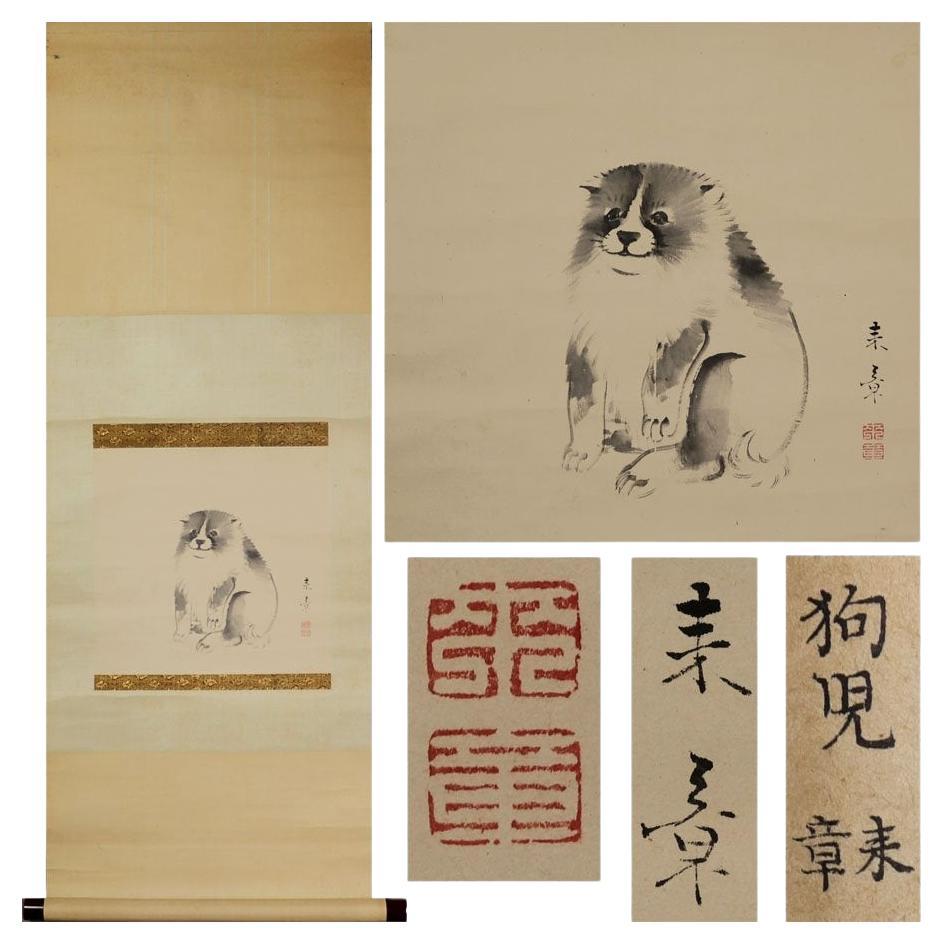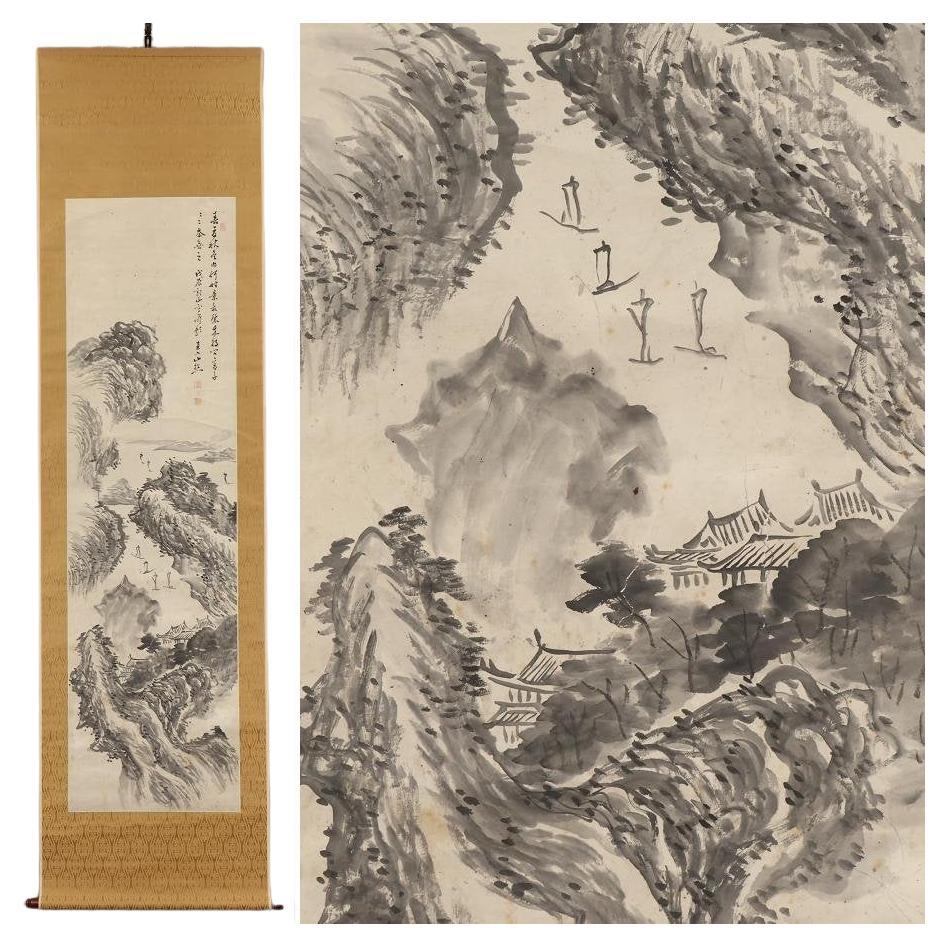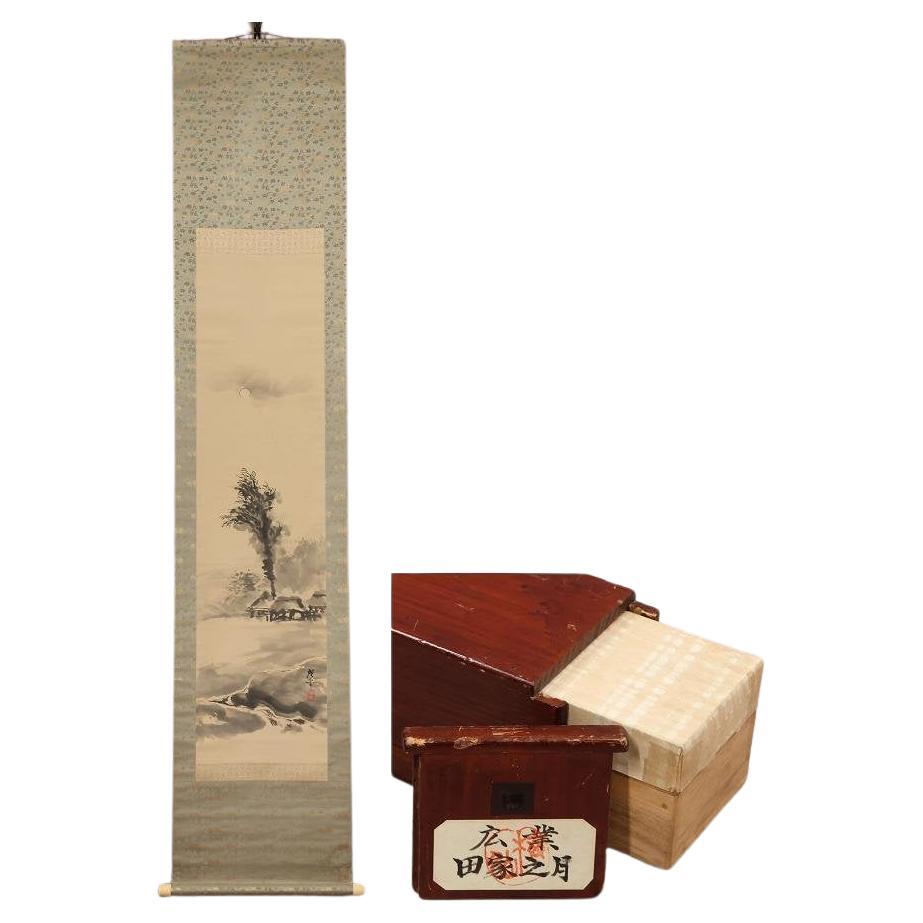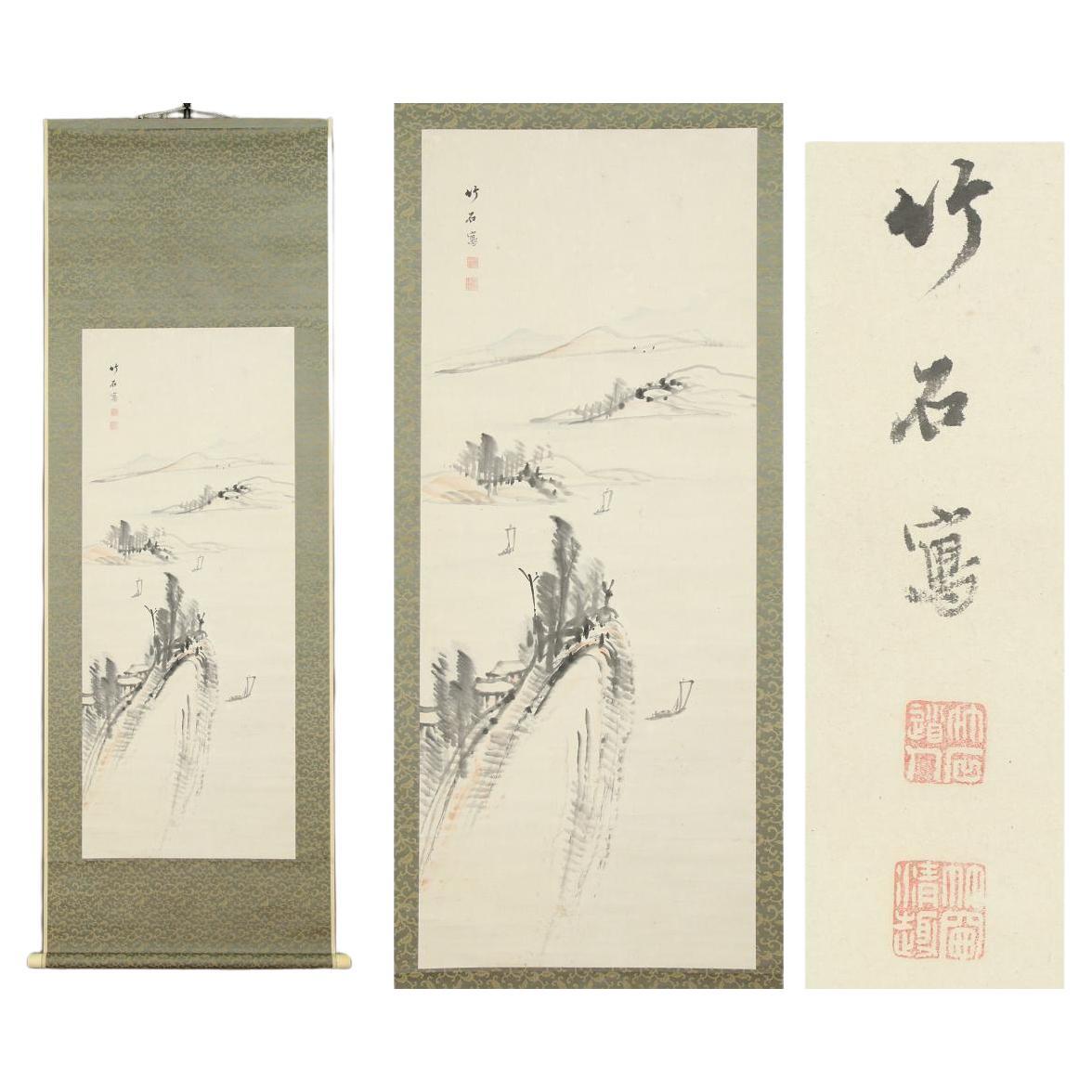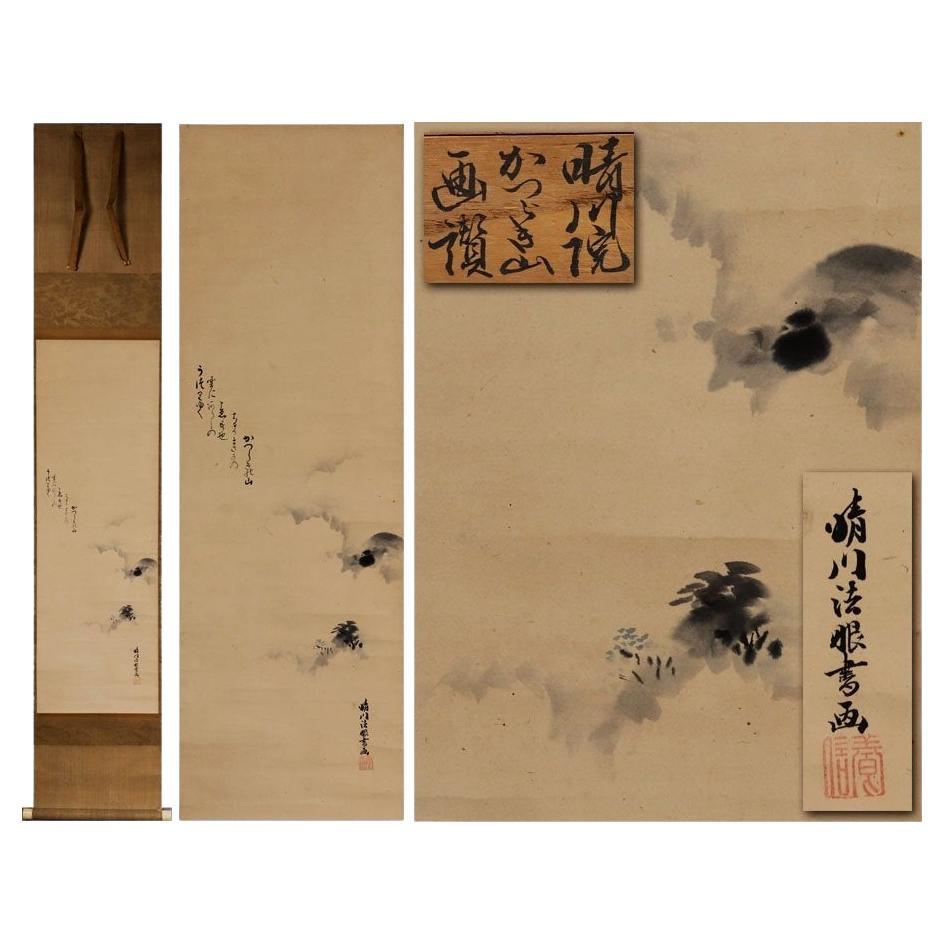Items Similar to Japanese Nihonga Painting 19th c Edo Scroll by Seiki Yokoyama Landscape Shijo
Want more images or videos?
Request additional images or videos from the seller
1 of 11
Japanese Nihonga Painting 19th c Edo Scroll by Seiki Yokoyama Landscape Shijo
About the Item
[Authentic work] ◆ Seiki Yokoyama ◆ Landscape ◆ Rural landscape ◆ Japanese painting ◆ Shijo school ◆ Hand-painted ◆ Paperback ◆ Hanging scroll ◆
Seiki Yokoyama
[Art yearbook appraised value 1.8 million yen]
1792 ( Kansei 4) - 1864 (Meiji 1)
Japanese painting, Shijo school
Yokoyama Seiki (1793-1865) was a student of Matsumura Keibun (1779-1843), a leading Shijo school painter. Seiki excelled at bird and flowers, and landscape paintings.
[Birthplace/master lineage]
Kyoto (Kyoto Prefecture) / Keifumi Matsumura
[Biography, style, etc.]
Studied under Keifumi Matsumura and mastered the Shijo school of painting techniques. He excelled in all painting subjects, including birds and beasts, flower petals, landscapes, and figures, and worked with Kishi Mountains, Bunrin Shiokawa, Raiaki Nakajima, and others. At that time, it was called one of the four great families of the Heian period.
He also presided over the ``Higashiyama Shunju Exhibition'' and displayed his works at restaurants in Kyoto, pioneering exhibitions in Japan, and further demonstrated his artistic ability when constructing the Kinri Imperial Palace in the Ansei era.
This work is drawn by hand and on paper.
The box is a combined box.
The paper has some small stains, wrinkles, and wrinkles, but is generally in good condition.
There are some small stains and wrinkles on the cover, but it is generally in good condition.
This is a guaranteed genuine product, so please bid accordingly.
Size:
Approximately [height 218cm x width 71cm/(main paper) 127cm x 57cm]
Stylistically, the Shijō style can best be described as a synthesis of two rival styles of the time. Maruyama Ōkyo was an experienced and expert painter of sumi-e ink paintings, and accomplished a great degree of realism in his creations, emphasizing direct observation of depicted subjects which was a direct contravention of the officially sponsored schools of the time, Kanō and Tosa, which emphasized decorativeness with highly formalized and stylized figures taught to its students via copying paintings of past masters. The Kanō and Tosa schools had become bywords for rigid formalism by this time. Meanwhile, a number of artists, rebelling against Ōkyo's realism, formed the nanga ("southern pictures") school, basing their style largely on the Southern school of Chinese painting. The artists of the Shijō school sought to reconcile the differences between these two styles, creating works that synthesized the best elements of both.
The school's style focuses on a Western-influenced objective realism, but achieved with traditional Japanese painting techniques. It concentrates less on the exact depiction of its subject, but rather on expressing the inner spirit and usually has an element of playfulness and humor compared to the Maruyama school. Popular motifs include tranquil landscapes, kachō (bird and flower), animals, and traditional subjects from Chinese poetic and Confucian lore, but there is generally little or no interest in legends, history, or classical literature.
- Dimensions:Height: 85.83 in (218 cm)Width: 27.96 in (71 cm)Depth: 0.04 in (1 mm)
- Style:Edo (Of the Period)
- Materials and Techniques:
- Period:
- Date of Manufacture:ca 1850
- Condition:Wear consistent with age and use.
- Seller Location:Amsterdam, NL
- Reference Number:
About the Seller
5.0
Gold Seller
These expertly vetted sellers are highly rated and consistently exceed customer expectations.
Established in 2015
1stDibs seller since 2019
158 sales on 1stDibs
Typical response time: 8 hours
- ShippingRetrieving quote...Ships From: Amsterdam, Netherlands
- Return PolicyA return for this item may be initiated within 14 days of delivery.
More From This SellerView All
- Japanese Nihonga Painting 19th c Edo Scroll by Nakajima Raiaki River landscapeLocated in Amsterdam, Noord Holland[Raisho Nakajima] lived from 1796 to 1871, at the end of the Edo period and early Meiji period. A person from Otsu, Omi Province (Shiga Prefecture). His name is Ziqing. His names i...Category
Antique 19th Century Edo Paintings
MaterialsSilk
- Japanese Nihonga Painting 19th c Edo Scroll by Tonomura Chokunyu River landscapeLocated in Amsterdam, Noord Holland[Authentic work] ◆Tanomura Chokunyu ◆Ink painting landscape ◆Japanese painting ◆Handpainted ◆ Paper ◆ Hanging scroll ◆ Chokunyu Tanomura 1814 (Bunka 11) - 1907 (Meiji 40) [Art yearbook appraised value 8 million yen] "A child prodigy in painting, Tanomura Chokunyu originally modeled himself after the style of the famous Tanomura Chikuden (1777-1835), who had adopted him at the age of eight. After Chikuden's death, Chokunyu took up an intense study of imported Chinese paintings." Paul Berry in: Literati Modern, p.136.) - The certificate box was inscribed by Tajika Chikuson (1864-1922), one of Chokunyu's key disciples. Around 1840, he studied Confucianism under Kotake Shinozaki in Osaka, deepened his friendships with Heihachiro Oshio and Tessai Tomioka through sencha, and began to be recognized as a painter. Furthermore, in 1862, he founded and hosted the Seiwan Tea Ceremony (a sencha tea ceremony), which achieved great fame. In 1868, he moved to Kyoto and participated in the establishment of the Kyoto Prefectural Painting School (opened in 1880), serving as its principal and making efforts to foster the next generation.Furthermore, in 1996, he established the Japan Nanga Association with Tessai and others, and established the Japan Nanga Association, which was established in modern Japan. He made a great contribution to painting and the southern painting...Category
Antique 19th Century Edo Paintings
MaterialsSilk
- Lovely Japanese 19th c Edo Scroll Okumura Sekiran Nihonga Painting MountainLocated in Amsterdam, Noord Holland"Early Summer Colored Waterfall" is a work drawn by Sekiran Okumura as you can see. The brilliance of the fresh greenery and the cool, powerful presence of the waterfall are overw...Category
Antique 18th Century Edo Paintings
MaterialsSilk
- Japanese Painting 19th Meiji Scroll Hiroyo Terasaki Landscape Shijo SchoolLocated in Amsterdam, Noord Holland[ Authentic work] ◆ Kogyo Terasaki (Hiroyo Terasaki) ◆ Tie no Tsuki ◆ Toriya Hatayama Box ◆ Double box ◆ Handpainted ◆ Paperback ◆ Hanging scroll ◆ Kogyo Terasaki (Hiroyo Terasaki) ...Category
Antique 19th Century Edo Paintings
MaterialsSilk
- Lovely Japanese 18/19th c Edo Scroll Kano Osanobu Nihonga Painting MountainLocated in Amsterdam, Noord HollandKano Osanobu (狩野養信) Osanobu Kano (born August 18, 1796; died June 12, 1846) was the ninth painter of the Kobikicho Kano School in the Edo period. His common name was Shozaburo. His ...Category
Antique 18th Century Edo Paintings
MaterialsSilk
- Japanese Nihonga Painting 18/19th c Edo Scroll Tanomura Chikuden Self PortraitLocated in Amsterdam, Noord HollandTanomura Takeda's handwritten self-portrait hymn "Painted Landscape" with himself working in a hut Takeda Tanomura and depicts fields and mountains in spring, and is accompanied by a self-written waka poem that is thought to be about the scene. [Tanomura Takeda] A painter from Takeda Village, Naoniri District, Bungo Province (present-day Takeda City). His family was born as the second son of Ken'an, who had been a samurai physician in the Oka domain for generations. He first studied medicine, but preferred learning over medicine, and studied Chinese studies under Kimizan Karahashi, a He also learned painting techniques from Buncho Tani, and after returning to Japan, he served as the president of a domain school. He resigned his post in 1812 and traveled between Keihan and Osaka, where he interacted with Raizanyo, Shinozaki Kotake, Urakami Gyokudo, Okada Yonezanjin, Unka Shonin, Aoki Mokubei...Category
Antique 18th Century Edo Paintings
MaterialsSilk
You May Also Like
- Japanese Edo Two Panel Screen Deities by Yokoyama KazanLocated in Rio Vista, CAWhimsical Japanese late Edo period two-panel screen circa 1800 by Yokoyama Kazan (Japanese 1784-1837). The screen depicts four of the seven Gods or deities ...Category
Antique 19th Century Japanese Edo Paintings and Screens
MaterialsBrass, Gold Leaf
- 19th Century Japanese Edo Six Panel Kano School Landscape ScreenLocated in Rio Vista, CALate Edo period 19th century Japanese six-panel landscape screen featuring a cypress tree over a flowering hibiscus with a pair of hototogisu birds. Kano school painted with ink and ...Category
Antique 19th Century Japanese Edo Paintings and Screens
MaterialsSilk, Wood, Paper
- 19th Century Japanese Scroll Painting by Igarashi Chikusa, Poppies & ButterfliesLocated in Kyoto, JPPoppies & Butterflies Ink, pigment and gofun on silk Igarashi Chikusa (1774-1844) Signature: Chikusa Ran Zen Upper Seal: Ran Shuzen Lower Seal: Kyoho Dimensions: Scroll: H. 68” x W. 18” (172cm x 45cm) Image: H. 38.5’’ x W. 12.5’’ (98cm x 32cm) This composition shows elegant images of poppies and the butterflies that are inevitably drawn to them. It captures a momentary glimpse into a world both visually dazzling and startlingly realistic. The painting is infused with sensitivity and attention to seasonal change and weather conditions. The thin and fragile poppies are beautifully depicted with brilliant colors and the butterflies are similarly infused with life. The painting is on silk which requires extremely precise painting skills as no element once painted can be removed. Poppies were a favorite subject of Rinpa school artists through the ages. Originally they were somewhat abstracted but by the age of Sakai Hoitsu...Category
Antique Early 19th Century Japanese Edo Paintings and Screens
MaterialsSilk
- Japanese Painting, Hanging Scroll, 19th Century Bamboo in MoonlightLocated in Kyoto, JPBamboo in moonlight Gamo Rakan (1784-1866) Hanging scroll, ink on silk. Dimensions: Scroll: 201 cm x 58 cm Image: 137 cm x 45 cm In this early 19th century work by Gamo Rakan a light ink wash applied to the silk background silhouettes the moon and suggests the atmosphere of early evening. Even though it is a literati subject, Rakan’s bamboo is quite realistic with a strong decorative style. The painting finds its inspiration from Chinese Ming dynasty painters who often used a single-tone, jet black stroke to emphasize the calligraphic nature of bamboo. In a different era, decorative would have been seen as somewhat unrefined. But increasingly in the Edo period, it was the hallmark of high style. The Japanese people, in particular the rising merchant class, had gradually become apathetic toward the traditional Sesshu and Kano schools of painting. Chinese professional and amateur painters living in the port of Nagasaki during the 18th century had a profound effect on Japanese painting and the freshness of their style and its decorative appeal contributed greatly to its popularity. Gamo Rakan’s teacher, Tani Buncho...Category
Antique Early 19th Century Japanese Edo Paintings and Screens
MaterialsSilk
- 19th Century Japanese Scroll Painting, Birds & Flowers of the Four SeasonsLocated in Kyoto, JPBirds and flowers of the four seasons Early to mid-19th century Ink, pigment and gofun on silk Unidentified artist Signature: S...Category
Antique 1830s Japanese Edo Paintings and Screens
MaterialsSilk
- Japanese Painting, Hanging Scroll, Mid 19th Century, Koi and Water PlantsBy Iwase HirotakaLocated in Kyoto, JPIwase Hirotaka (1808-1877) Koi and Water Plants Hanging scroll, ink, color, gold wash and gold flecks on silk Inscription: Hirotaka Seal: Ille...Category
Antique 1860s Japanese Edo Paintings and Screens
MaterialsSilk
